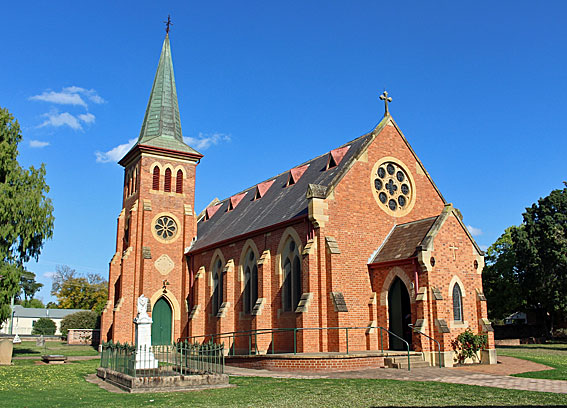
St Luke's Anglican Church, Scone:
exterior from the north-west
[photograph by Trevor Bunning (2 October 2015)]

St Luke's Anglican Church, Scone:
exterior from the north-west
[photograph by Trevor Bunning (2 October 2015)]
Historical and Technical Documentation by Kelvin Hastie
© OHTA, 2015 (last updated September 2015)
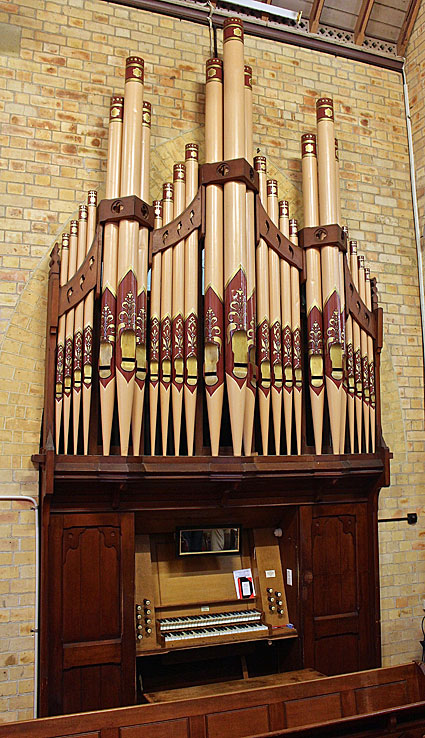
St Luke's Anglican Church, Scone: organ
[photograph by Trevor Bunning (2 October 2015)]
St Luke's was built in 1883-84 to replace an older church erected in 1841. The current structure is red-brick with stone dressings and was designed by John Wiltshire Pender (1833-1917) who was a Maitland sketcher, architect and builder. He arrived in the Hunter district in 1857 and set up his architectural practice in 1863. St Luke's is of an early English Gothic design and is set among well-established trees. The bell was provided by William Dangar for the first church. Thomas Cook and J.H. Doyle, of Invermein, made substantial contributions. Cook is buried in the churchyard cemetery which was the first in the shire, being used between 1838 and 1864. It includes the Dangar family vault, located near the chancel. The rectory was built in 1925.1
A report in The Maitland Mercury and Hunter River General Advertiser of 21 October 1884 provides a description of the building, which includes the following observations:
Newcastle pressed bricks of red colour are used for the external walls, while similar bricks, but buff in colour, form the internal walls. The arches of the windows and those of the chancel and over the doors are white brick, tuck pointed. The roof is covered with the best Bangor slate, and the spire with Muntz metal. Cathedral glass has been employed in the windows; those in the nave have a rim of red, and those in the chancel a rim of yellow. The large east window is stained glass, and was supplied by Messrs. Ashwin and Falconer, of Sydney. The subject is the Ascension, and it has been treated in a very beautiful manner.
Ventilation is provided for through the windows, by sliding ventilators in the walls, and by dormer ventilators in the roof, and the whole building is protected by a lightning conductor. The principals of the roof are grained in dark oak, and the chamferings picked out in contrasting colours. The lining of the roof is painted French grey, and the rafters are done in buff, and picked out in Venetian red. Kauri pine has been used for the seats and most of the other furniture of the church. . . The communion table is cedar. A very handsome brass lectern is comprised in the furniture; it was the gift of Mr James Wilshire. The font is of Waratah stone from Whiteman's quarry, and was carved by one of the workmen. The contractor, Mr. Parkhill, has done the [building work] faithfully to the entire satisfaction of the architect. Mr. J.W. Pender and the result is creditable to all concerned. The furniture is no less by Mr. W.E. Norman in West Maitland… [There is a capacity] for 280 persons, but additional seats in the chancel occupied by the choir will increase the accommodation to over three hundred. The total cost up to Saturday was £4200.2
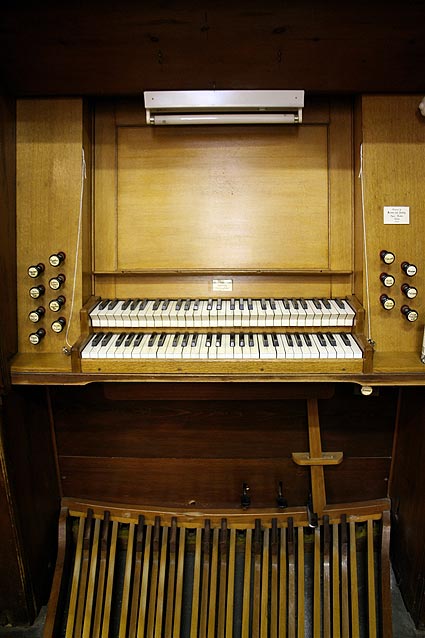
St Luke's Anglican Church, Scone: console
[photograph by Trevor Bunning (September 2007)]
Extensive notes on the acquisition of the organ, built in 1887 by Halmshaw & Sons, of Birmingham, are provided by Graeme Rushworth in Historic Organs of New South Wales: the instruments, their makers and players, 1791-1940. No other instruments were provided by this firm to New South Wales, although a much-travelled small instrument of four stops, dating from the 1860s, survives at the residence of Bruce Fethers at Craigie in Victoria.3 Rushworth records that the organ was built at a cost £208, received in Scone in February 1888 and erected by James P. Broderick of Maitland. Electric blowing was supplied in 1931 and in 1949 C.W. Leggo fitted tubular-pneumatic action to the pedals.4
The organ was restored in 1980 by Brown & Arkley of Sydney. John Stiller carried out a detailed documentation of the organ in 1983 and noted that the base colour of the display pipes was originally a pastel pink. This was changed to a flesh colour to match the internal brickwork of the church. The firm also replaced the key coverings in new ivory.5
Stiller also noted that tuning slides had been added to all internal open metal pipes, a tremulant had been provided for the Swell, the pedalboard had been replaced by one of concave and radiating design and that several anomalies were evident in the inscriptions on the pipework of the two Principal 4 stops.
He discovered that c1 – g3 of the "Principal Sw" is a cut-down Harmonic Flute, but as the stop dome is original, the Swell must have always had a Principal. The dome for the Great Principal is a replacement for one that had apparently been missing for a number of years and the rank is now made up of pipes from a variety of sources, with some pipes labelled "Harmonic Flute". In addition, the rackboard holes are felted, suggesting an adjustment was made for the fitting of replacement pipes of narrower scale. Stiller conjectures that the Swell Principal and a possible Great Harmonic Flute 4 might have been swapped at some stage, the organ being originally supplied without a Great Principal 4.6
In spite of these alterations, the organ possesses many of its original features, including an original mechanical key, stop and combination action, soundboards, swell box, double-rise bellows and associated hand-blowing mechanism, and virtually all case and console fittings, including a remnant pulley of the blower's telltale.
In his statement of significance, John Stiller stated that:
This organ represents a rare Australasian example of a skilled firm of nineteenth century English organbuilders. It exhibits a very high standard of craftsmanship and design, particularly in regard to the superbly constructed key and stop actions. The pleasant tonal qualities of this fine instrument make it an excellent example of the work of Halmshaw & Sons. 7
The specification of the organ is:
| GREAT Open Diapason Höhlflöte Dulciana Principal Fifteenth SWELL Open Diapason Sw. Leiblich Gedact Sw. Vox Angelica Sw. Principal Sw. Hautboy Sw. Tremulant PEDAL Pedal Bourdon COUPLERS Great to Pedals Swell to Pedals Swell to Great |
[8] [8] [8] [4] [2] [8] [8] [8] [4] [8] 16ft. |
[sic] + # [sic] # TC [knob under keydesk] |
Mechanical action to the manuals and stops
Tubular-pneumatic action to the pedals
Compass 56/30
Total number of pipes: 554
Pitch a=440 Hz at 150 C
2 composition pedals for Great
Hitch-down swell pedal
+ C-B from Höhlflöte
# C-B from Leiblich Gedact8
1. http://www.sconeanglicanchurch.org.au/about/history/, www.libguides.newcastle.edu.au/pender and www.daao.org.au/bio/john-wiltshire-pender. Accessed by Kelvin Hastie, 5 September 2015.
2. The Maitland Mercury and Hunter River General Advertiser, 21 October 1884, p.4. Information provided by John Maidment, June 2015.
3. John Maidment, Gazetteer of Victorian Pipe Organs (updated May 2015), http://www.ohta.org.au/gaz/vicgaz.htm. Accessed by Kelvin Hastie, 5 September 2015.
4. Graeme Rushworth, Historic Organs of New South Wales. Sydney: Hale & Iremonger, 1988, p.260.
5. John Stiller, "Detailed Documentation of Pipe Organ built by Halmshaw & Sons 1887". Organ Historical Trust of Australia, 8 and 9 June 1983, p.3.
6. Ibid., p.5.
7. Ibid., p.6.
8. Ibid., p.7.
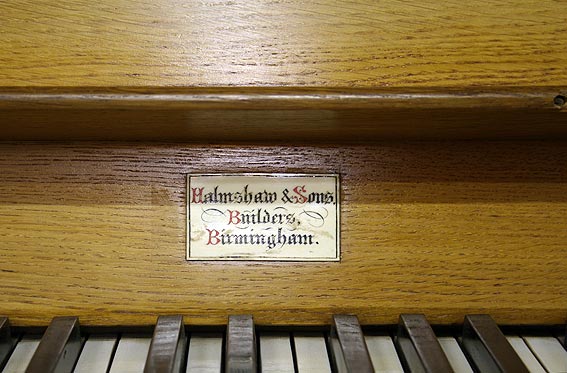
St Luke's Anglican Church, Scone: nameplate
[photograph by Trevor Bunning (September 2007)]
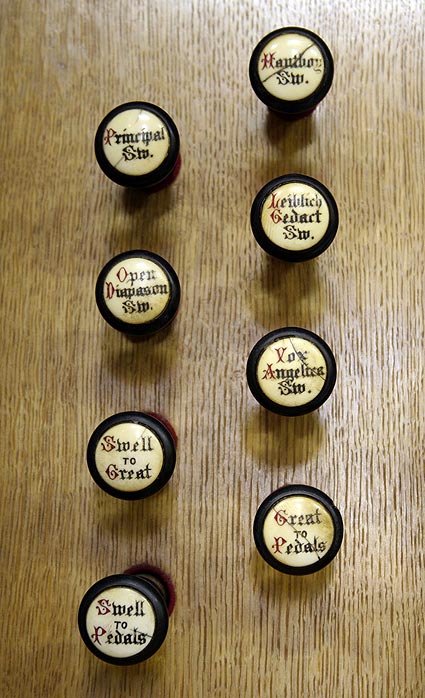
St Luke's Anglican Church, Scone: left-hand stop jamb
[photograph by Trevor Bunning (September 2007)]
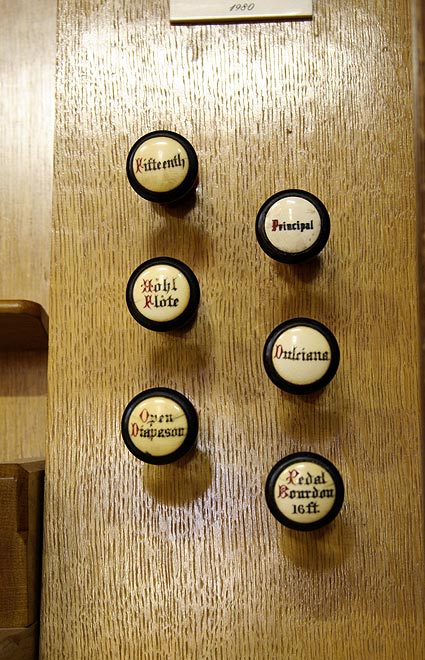
St Luke's Anglican Church, Scone: right-hand stop jamb
[photograph by Trevor Bunning (September 2007)]
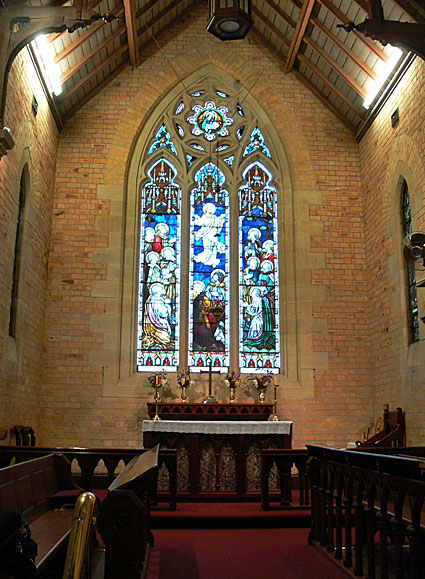
St Luke's Anglican Church, Scone: chancel
[photograph by John Maidment (2 October 2015)]
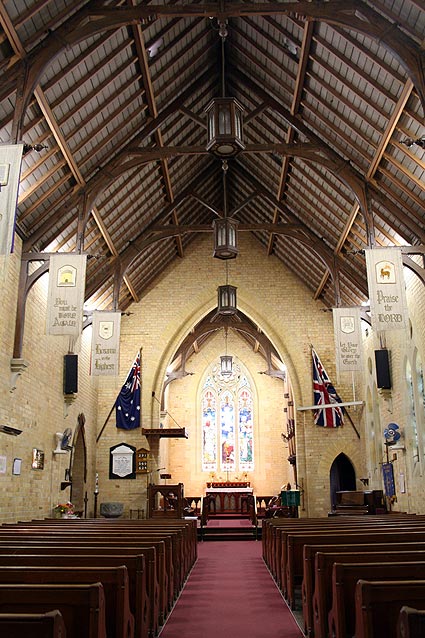
St Luke's Anglican Church, Scone: interior
[photograph by Trevor Bunning (September 2007)]
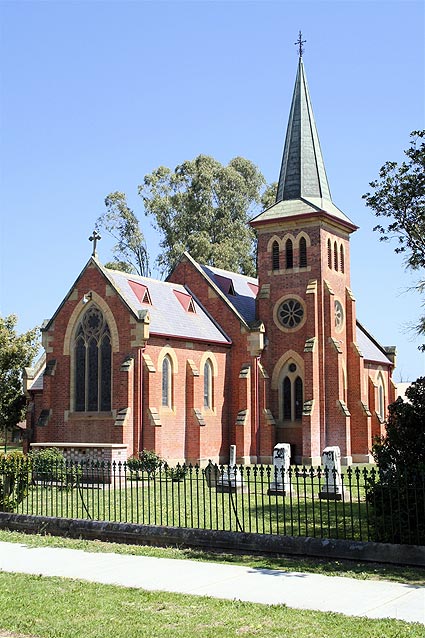
St Luke's Anglican Church, Scone: exterior from the north-east
[photograph by Trevor Bunning (September 2007)]